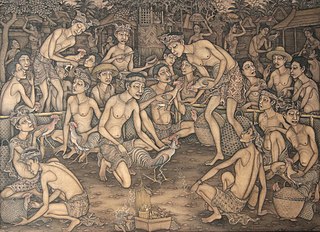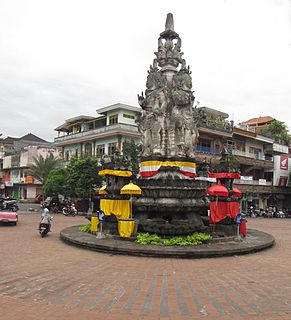Related Research Articles

I Nyoman Windha is one of the leading musicians and contemporary composers of Balinese gamelan music. He was born at Banjar Kutri, Singapadu, Gianyar, Bali. A graduate of the National Institute of Arts (ISI) in Denpasar, Bali, Windha has been a member of the faculty since 1985. He has composed dozens of compositions for Balinese gamelan in many genres but primarily in kebyar style. His compositions, such as Puspanjali (1989), have been incorporated into the standard repertoire of Balinese performing groups and many have won awards at Bali's annual gamelan competition.

The Balinese people are an Austronesian ethnic group and nation native to the Indonesian island of Bali. The Balinese population of 4.2 million live mostly on the island of Bali, making up 89% of the island's population. There are also significant populations on the island of Lombok and in the easternmost regions of Java.

Besakih Temple is a pura complex in the village of Besakih on the slopes of Mount Agung in eastern Bali, Indonesia. It is the most important, the largest and holiest temple of Balinese Hinduism, and one of a series of Balinese temples. Perched nearly 1000 meters up the side of Gunung Agung, it is an extensive complex of 23 separate but related temples with the largest and most important being Pura Penataran Agung. The temple is built on six levels, terraced up the slope. The entrance is marked by a candi bentar, and beyond it the Kori Agung is the gateway to the second courtyard.
Anak Agung Pandji Tisna, also known as Anak Agung Nyoman Pandji Tisna, I Gusti Nyoman Pandji Tisna, or just Pandji Tisna, was the 11th descendant of the Pandji Sakti dynasty of Buleleng, Singaraja, which is in the northern part of Bali, Indonesia. He succeeded his father, Anak Agung Putu Djelantik, in 1944.
I Ketut Soki is a successful artist from Bali. As a boy, he was one of the first two children to receive art lessons from the famous artist Arie Smit, and so one of the founders of the "Young Artists" movement.

Balinese art is art of Hindu-Javanese origin that grew from the work of artisans of the Majapahit Kingdom, with their expansion to Bali in the late 14th century. From the sixteenth until the twentieth centuries, the village of Kamasan, Klungkung, was the centre of classical Balinese art. During the first part of the twentieth century, new varieties of Balinese art developed. Since the late twentieth century, Ubud and its neighboring villages established a reputation as the center of Balinese art.

Museum Rudana or Rudana Art Museum is an art museum in Peliatan, Gianyar Regency, Bali, Indonesia. It was built by Nyoman Rudana, following the concept of the Bali humanist philosophy of Tri Hita Karana, where art makes a contribution to public wellbeing.
Nyoman Rudana is a former member of the Regional Representatives Council of Indonesia. He is also the founder and owner of Museum Rudana, Rudana Fine Art Gallery and Genta Fine Art Gallery, and founder of artist support organizations in Ubud, Bali.
I Nyoman Renbang (1937–2001) was an Indonesian musician, composer, teacher and instrument maker. He is considered by many ethnomusicologists as one of the most influential Balinese musicians and composers of the twentieth century.

Ngaben, also known as Pitra Yadyna, Pelebon or cremation ceremony, is the Hindu funeral ritual of Bali, Indonesia. A Ngaben is performed to release the soul of a dead person so that it can enter the upper realm where it can wait for it to be reborn or become liberated from the cycles of rebirths. The Balinese Hindu theology holds that there is a competition between evil residents of the lower realm to capture this soul, and a proper cremation enhances the chance that it may reach the upper realm.
I Nyoman Ngendon (1906-1946). I Nyoman Ngendon was among the first Batuan painters who embraced the modernization of Balinese art that took place around the beginning of the 1930s. Ngendon first learned the Wayang-style painting from I Dewa Nyoman Mura, a well-known painter in Batuan. Walter Spies' influence can be seen in their early works . His works can be found in several museums throughout the world. In Bali, his works can be viewed at the Museum Puri Lukisan and the Agung Rai Museum of Art (ARMA). In the Netherlands, his works can be found at the Rijksmuseum voor Volkenkunde, Leiden and the Tropenmuseum, Amsterdam.
Ida Bagus Nyoman Rai (~1915-2000) was a traditional Balinese painter from Sanur, a beach resort near Denpasar, Bali, Indonesia. He was also known as I Bagus Nyoman Rai Tengkeng or Ida Bagus Nyoman Rai Klingking

The Puri Lukisan Ratna Wartha Museum is the oldest art museum in Bali which specialize in modern traditional Balinese paintings and wood carvings. The museum is located in Ubud, Bali, Indonesia. It is home to the finest collection of modern traditional Balinese painting and wood carving on the island, spanning from the pre-Independence war (1930–1945) to the post-Independence war era. The collection includes important examples of all of the artistic styles in Bali including the Sanur, Batuan, Ubud, Young Artist and Keliki schools.

Gambuh is an ancient form of Balinese dance-drama. It is accompanied by musicians in a gamelan gambuh ensemble.

Semarapura is a town which serves as the administrative capital of the Klungkung Regency in Bali, Indonesia.
Balinese literature refers to the oral and written Balinese language literature of the people of Bali, an island in Indonesia. It is generally divided into two periods: purwa, or traditional; and anyar, or modern.
Nemoe Karma is a 1931 novel by I Wayan Gobiah. It is the first Balinese language novel.

Tipat cantok is a Balinese popular local dish. It is made of various boiled or blanched vegetables with ketupat rice cake, served in spicy peanut sauce. In Balinese language tipat means ketupat, while cantok means grounding ingredients using mortar and pestle. Vegetables usually being used in this dish are asparagus bean, beansprout, water spinach, and tofu. This is a common street food, which is popular among tourists as well as locals.

Pura Taman Saraswati, officially Pura Taman Kemuda Saraswati, also known as the Ubud Water Palace, is a Balinese Hindu temple in Ubud, Bali, Indonesia. The pura is dedicated to the goddess Sarasvati. Pura Taman Saraswati is notable for its lotus pond.

Pura Dalem Segara Madhu also known as Pura Dalem Jagaraga is a northern Balinese Hindu temple or pura located in the village of Jagaraga, Buleleng in northern Bali. It is about 11 km east of Singaraja. The village of Jagaraga is known historically as the place where the Dutch colonial government witnesses puputan or Balinese mass-suicide following their military attack on the kingdom of Bali in 1849. Pura Dalem Segara Madhu is known for its intensive wall decoration typical of northern Balinese architecture and for its unique western-influenced relief e.g. motifs of early 20th-century airplanes and automobiles.
References
- ↑ Cerita, Nyoman; Wiraman, AA Bagus; Suarka, I Nyoman (May 2017). "The Barong Landung Performing Art from the Perspective of Cultural Acculturation". E-Journal of Cultural Studies. 10 (2): 1–6.
- ↑ "Bali Theatre in the Park" (PDF). Bali Hotels Association.